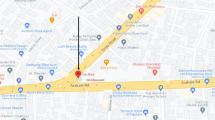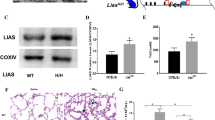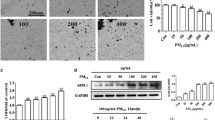Abstract
Exposure to dust storm particulate matter (PM) is detrimental to kidney tissue. In this study, the impacts of chronic intake of dusty PM were explored as a major objective in a specified compartment to make a real-like dust storm (DS) model, and the role of hesperidin (HSP) as an antioxidant on kidney tissue was assessed in rats. Thirty-two male Wistar rats (200-220 g) were randomly allocated into 4 groups: CA+NS: (clean air and normal saline as a vehicle of HSP). Dusty PM and NS (DS+NS). HSP+ CA: rats received 200 mg/kg of HSP by gavage for 28 days, once daily in addition to exposure to clean air. HSP+DS: HSP plus DS. In DS groups, the animals were exposed to dust storms at a concentration of 5000-8000 μg/m3 in the chamber for 1 h daily, for 4 consecutive weeks, except Thursdays and Fridays. At the end of the experiment, the animals were sacrificed for biochemical, inflammatory, oxidative stress, molecular parameters, and histological evaluation. DS significantly enhanced blood urea nitrogen and creatinine, inflammatory (tumor necrosis factor-α, and interleukin-1β), and oxidative stress indexes. Likewise, a significant increase was seen in mRNA Smads, collagen-I, and transforming growth factor-β1 (TGF-β1) expressions in the kidney. Histological findings showed contracted glomeruli and kidney structure disorder. In addition, Masson’s trichrome staining demonstrated renal fibrosis. Nevertheless, HSP could significantly reverse these changes. Our data confirmed that DS results in kidney fibrosis through enhancing Smads/TGF-β1 signaling. However, HSP was able to inhibit these changes as confirmed by histological findings.
Graphical abstract








Similar content being viewed by others
Data availability
All data generated or analyzed during the current study are available from the corresponding author upon reasonable request.
Abbreviations
- DS:
-
dust storm
- PM:
-
particulate matter
- HSP:
-
hesperidin
- TGF-β1:
-
transforming growth factor-β1
- CKD:
-
Chronic kidney diseases
- ROS:
-
reactive oxygen species
- TNF-α:
-
tumor necrosis factor-α
- IL-1β:
-
interleukin-1β
- TAC:
-
total antioxidant capacity
- MDA:
-
malondialdehyde
- RNA:
-
ribonucleic acid
- DNA:
-
deoxyribonucleic acid
- BUN:
-
blood urea nitrogen
- Cr:
-
creatinine
- PBS:
-
phosphate-buffered saline
- qRT-PCR:
-
quantitative real-time PCR
- GAPDH:
-
glyceraldehyde-3-phosphate dehydrogenase
- H&E:
-
hematoxylin/eosin
- MTS:
-
Masson’s Trichrome staining
- ANOVA:
-
one-way analysis of variance
- SEM:
-
mean ± standard error
- Bax:
-
Bcl-2 associated x protein
References
Abou Seif HS (2012) Protective effect of rulin and hespridin against doxorubicin induced nephrotoxicity. Beni-Suef Univ J App Sci 1(2):1–18
Adil M, Kandhare AD, Visnagri A, Bodhankar SL (2015) Naringin ameliorates sodium arsenite-induced renal and hepatic toxicity in rats: decisive role of KIM-1, Caspase-3, TGF-beta, and TNF-alpha. Ren Fail 37(8):1396–1407
Adwas AA, Elsayed A, Azab A, Quwaydir F (2019) Oxidative stress and antioxidant mechanisms in human body. J Appl Biotechnol Bioeng 6(1):43–47
Afsar B, Elsurer Afsar R, Kanbay A, Covic A, Ortiz A, Kanbay M (2019) Air pollution and kidney disease: review of current evidence. Clin Kidney J 12(1):19–32
Amini N, Badavi M, Mard SA, Dianat M, Taherimoghadam M (2022) The renoprotective effects of gallic acid on cisplatin-induced nephrotoxicity through anti-apoptosis, anti-inflammatory effects, and downregulation of lncRNA TUG1. Naunyn Schmiedebergs Arch Pharmacol 395(6):691–701
Anandan R, Subramanian P (2012) Renal protective effect of hesperidin on gentamicin-induced acute nephrotoxicity in male Wistar albino rats. Redox Rep 17(5):219–226
Aztatzi-Aguilar O, Uribe-Ramírez M, Narváez-Morales J, De Vizcaya-Ruiz A, Barbier O (2016) Early kidney damage induced by subchronic exposure to PM 2.5 in rats. Part Fibre Toxicol 13(1):1–20
Busso IT, Mateos AC, Juncos LI, Canals N, Carreras H (2018) Kidney damage induced by sub-chronic fine particulate matter exposure. Environ Int 121:635–642
Cao G, Sofic E, Prior RL (1997) Antioxidant and prooxidant behavior of flavonoids: structure-activity relationships. Free Radic biol Med 22(5):749–760
Chen B, Kan H (2008) Air pollution and population health: a global challenge. Environ Health Prev Med 13(2):94–101
Chenxu G, Minxuan X, Yuting Q, Tingting G, Jinxiao L, Mingxing W, Sujun W, Yongjie M, Deshuai L, Qiang L (2018) iRhom2 loss alleviates renal injury in long-term PM2. 5-exposed mice by suppression of inflammation and oxidative stress. Redox Biol 19:147–157
Chung AC, Zhang H, Kong YZ, Tan JJ, Huang XR, Kopp JB, Lan HY (2010) Advanced glycation end-products induce tubular CTGF via TGF-β–independent Smad3 signaling. J A So Nephro 21(2):249–260
Dalle-Donne I, Rossi R, Colombo R, Giustarini D, Milzani A (2006) Biomarkers of oxidative damage in human disease. Clin Chem 52(4):601–623
De Matos ACC, Câmara NOS, De Oliveira AFF, Franco MF, Moura LAR, Nishida S, Pereira AB, Pacheco-Silva A (2010) Functional and morphologic evaluation of kidney proximal tubule and correlation with renal allograft prognosis. Transpl Int 23(5):493–499
Du N, Xu Z, Gao M, Liu P, Sun B, Cao X (2018) Combination of Ginsenoside Rg1 and Astragaloside IV reduces oxidative stress and inhibits TGF-β1/Smads signaling cascade on renal fibrosis in rats with diabetic nephropathy. Drug De Devel Ther 12:3517
Du Y, Xu X, Chu M, Guo Y, Wang J (2016) Air particulate matter and cardiovascular disease: the epidemiological, biomedical and clinical evidence. J Thorac Dis 8(1):E8–E19
Feng S, Gao D, Liao F, Zhou F, Wan X (2016) The health effects of ambient PM2. 5 and potential mechanisms. Ecotoxicol Environ Saf 128:67–74
Gaschler MM, Stockwell BR (2017) Lipid peroxidation in cell death. Biochem Biophy Res Commun 482(3):419–425
Gioda A, Peréz U, Rosa Z, Jimenez-Velez BD (2007) Particulate matter (PM~ 1~ 0 AND PM~ 2~.~ 5) from different areas of puerto RICO. Fresenius Environ Bull 16(8):861
Hajipour S, Farbood Y, Gharib-Naseri MK, Goudarzi G, Rashno M, Maleki H, Bakhtiari N, Nesari A, Khoshnam SE, Dianat M, Sarkaki B (2020) Exposure to ambient dusty particulate matter impairs spatial memory and hippocampal LTP by increasing brain inflammation and oxidative stress in rats. Life Sci 242:117210
Hanedan B, Ozkaraca M, Kirbas A, Kandemir FM, Aktas MS, Kilic K, Comakli S, Kucukler S, Bilgili A (2018) Investigation of the effects of hesperidin and chrysin on renal injury induced by colistin in rats. Biomed Pharmacother 108:1607–1616
Havsteen BH (2002) The biochemistry and medical significance of the flavonoids. Pharmacol Ther 96(2-3):67–202
Hoffmann C, Funk R, Sommer M, Li Y (2008) Temporal variations in PM10 and particle size distribution during Asian dust storms in Inner Mongolia. Atmos Environ 42(36):8422–8431
Hu H-H, Chen D-Q, Wang Y-N, Feng Y-L, Cao G, Vaziri ND, Zhao Y-Y (2018) New insights into TGF-β/Smad signaling in tissue fibrosis. Chem Biol Interact 292:76–83
Huang X, Shi X, Zhou J, Li S, Zhang L, Zhao H, Kuang X, Li J (2020) The activation of antioxidant and apoptosis pathways involved in damage of human proximal tubule epithelial cells by PM 2.5 exposure. Environ Sci Eu 32(1):1–13
Isaka Y (2018) Targeting TGF-β Signaling in Kidney Fibrosis. Int J Mol Sci 19. https://doi.org/10.3390/ijms19092532
Jimenez-Velez B, Detrés Y, Armstrong RA, Gioda A (2009) Characterization of African dust (PM2. 5) across the Atlantic Ocean during AEROSE 2004. Atmos Environ 43(16):2659–2664
Kandemir FM, Ozkaraca M, Küçükler S, Caglayan C, Hanedan B (2018) Preventive effects of hesperidin on diabetic nephropathy induced by streptozotocin via modulating TGF-β1 and oxidative DNA damage. Toxin Rev 37(4):287–293
Kim H-J, Min J-y, Seo Y-S, Min K-b (2018) Association between exposure to ambient air pollution and renal function in Korean adults. Ann Occup Environ Med 30(1):1–7
Lan HY (2011) Diverse roles of TGF-β/Smads in renal fibrosis and inflammation. Int J Biol Sci 7(7):1056–1067
Liu Y (2011) Cellular and molecular mechanisms of renal fibrosis. Nat Rev Nephrol 7(12):684–696
Lodovici M, Bigagli E (2011, 2011) Oxidative stress and air pollution exposure. J Toxicol. https://doi.org/10.1155/2011/487074
Mahmoud AM, Mohammed HM, Khadrawy SM, Galaly SR (2017) Hesperidin protects against chemically induced hepatocarcinogenesis via modulation of Nrf2/ARE/HO-1, PPARγ and TGF-β1/Smad3 signaling, and amelioration of oxidative stress and inflammation. Chem Biol Interact 277:146–158
Maiorino M, Conrad M, Ursini F (2018) GPx4, lipid peroxidation, and cell death: discoveries, rediscoveries, and open issues. Antioxid Redox Signal 29(1):61–74
Milojevic A, Wilkinson P, Armstrong B, Bhaskaran K, Smeeth L, Hajat S (2014) Short-term effects of air pollution on a range of cardiovascular events in England and Wales: case-crossover analysis of the MINAP database, hospital admissions and mortality. Heart 100(14):1093–1098
Nemmar A, Al-Salam S, Zia S, Yasin J, Al Husseni I, Ali BH (2010) Diesel exhaust particles in the lung aggravate experimental acute renal failure. Toxicol Sci 113(1):267–277
Pari L, Karthikeyan A, Karthika P, Rathinam A (2015) Protective effects of hesperidin on oxidative stress, dyslipidaemia and histological changes in iron-induced hepatic and renal toxicity in rats. Toxicol Rep 2:46–55
Park H, Kim M-J, Ha E, Chung J-H (2008) Apoptotic effect of hesperidin through caspase3 activation in human colon cancer cells, SNU-C4. Phytomedicine 15:147–151
Sahu BD, Kuncha M, Sindhura GJ, Sistla R (2013) Hesperidin attenuates cisplatin-induced acute renal injury by decreasing oxidative stress, inflammation and DNA damage. Phytomedicine 20:453–460
Seltenrich N (2016) PM2. 5 and kidney function: long-term exposures may lead to modest declines. Environ.Health. Sci. 124:A168. https://doi.org/10.1289/ehp.124-A168
Subramanian P, Anandan R, Jayapalan JJ, Hashim OH (2015) Hesperidin protects gentamicin-induced nephrotoxicity via Nrf2/HO-1 signaling and inhibits inflammation mediated by NF-κB in rats. J Funct Foods 13:89–99
Turk E, Kandemir FM, Yildirim S, Caglayan C, Kucukler S, Kuzu M (2019) Protective effect of hesperidin on sodium arsenite-induced nephrotoxicity and hepatotoxicity in rats. Biol Trace Elem Res 189(1):95–108
Turner MC, Krewski D, Pope III CA, Chen Y, Gapstur SM, Thun M. J (2011) Long-term ambient fine particulate matter air pollution and lung cancer in a large cohort of never-smokers. Am J Respir Crit Care Med 184(12):1374-1381.
Valavanidis A, Vlachogianni T, Fiotakis K, Loridas S (2013) Pulmonary oxidative stress, inflammation and cancer: respirable particulate matter, fibrous dusts and ozone as major causes of lung carcinogenesis through reactive oxygen species mechanisms. Int J Environ Res Public Health 10:3886–3907
Wang G, Jiang R, Zhao Z, Song W (2013) Effects of ozone and fine particulate matter (PM2. 5) on rat system inflammation and cardiac function. Toxicol lett 217(1):23–33
Xu M-X, Qin Y-T, Ge C-X, Gu T-T, Lou D-S, Li Q, Hu L-F, Li Y-Y, Yang W-W, Tan J (2018) Activated iRhom2 drives prolonged PM2. 5 exposure-triggered renal injury in Nrf2-defective mice. Nanotoxicology 12(9): 1045-1067.
Yang Y-R, Chen Y-M, Chen S-Y, Chan C-C (2017) Associations between long-term particulate matter exposure and adult renal function in the Taipei metropolis. Environ. Health Perspect 125(4):602–607
Zhang Y, Wang B, Guo F, Li Z, Qin G (2018) Involvement of the TGFβ1-ILK-Akt signaling pathway in the effects of hesperidin in type 2 diabetic nephropathy. Biomed Pharmacother 105:766–772
Acknowledgements
The authors would like to express their gratitude for the assistance of the Persian Gulf Physiology Research Center, Ahvaz Jundishapur University of Medical Sciences.
Funding
This work was supported financially by the Persian Gulf Physiology Research Center (APRC-0017) funded by the Vice Chancellor of Research, Ahvaz Jundishapur University of Medical Sciences, Ahvaz, Iran.
Author information
Authors and Affiliations
Contributions
NA designed the study and wrote the manuscript. AS contributed to the technical advising and critical revision of the manuscript. MB performed the data analysis and interpreted the results. FN performed molecular analysis. SH contributed to the data collection. ZB performed the histology. All authors read and approved the final version of the manuscript. The authors declare that all data were generated in-house and that no paper mill was used.
Corresponding author
Ethics declarations
Ethical considerations
The current research was confirmed by the Animal Ethics Committee of Ahvaz Junidshapur University of Medical Sciences, Iran (IR.AJUMS.ABHC.REC.1400.095).
Consent to participate
This is an animal study.
Consent for publication
All authors agree to publish.
Competing interests
The authors declare no competing interests.
Additional information
Publisher’s note
Springer Nature remains neutral with regard to jurisdictional claims in published maps and institutional affiliations.
Rights and permissions
Springer Nature or its licensor (e.g. a society or other partner) holds exclusive rights to this article under a publishing agreement with the author(s) or other rightsholder(s); author self-archiving of the accepted manuscript version of this article is solely governed by the terms of such publishing agreement and applicable law.
About this article
Cite this article
Sarkaki, A., Badavi, M., Nejaddehbashi, F. et al. The renoprotective effects of hesperidin on kidney injury induced by exposure to severe chronic dust storm particulate matter through inhibiting the Smads/TGF-β1 signaling in rat. Naunyn-Schmiedeberg's Arch Pharmacol 396, 3615–3626 (2023). https://doi.org/10.1007/s00210-023-02562-x
Received:
Accepted:
Published:
Issue Date:
DOI: https://doi.org/10.1007/s00210-023-02562-x




